History
![]() News
News ![]() Products
Products ![]() Pricing
Pricing ![]() Distribution
Distribution ![]() Notes & Interesting Articles
Notes & Interesting Articles
Binoculars
![]() Telescopes
Telescopes
![]() Cameras
Cameras ![]() Accessories
Accessories ![]() Warranty / Service & Repair
Warranty / Service & Repair
 7 x 42, 8 x 42, and 10 x 42 ULTRAVID HD Binoculars
7 x 42, 8 x 42, and 10 x 42 ULTRAVID HD Binoculars

Above center: Leica ULTRAVID 42mm BR binocular at left, BL at right on display at Company Seven.
click on image to see enlarged view (202,818 bytes)
Leica binoculars have traditionally set the standards of brilliance, sharpness and brightness when it comes to meeting the objectives of turning observations that are rich in details into an unforgettable experience, even at great distances. And now, Leica has succeeded in establishing an entirely new standard of excellence with their introduction of the ULTRAVID binocular line announced 10 August 2003, while deliveries started in December 2003.
Left: Leica ULTRAVID automated presentation (269,609 bytes) showing 50mm BR model at introduction with overview of the product construction and components features. Click "Start Film" below and right of illustrated ULTRAVID 50mm binocular image to view.
Note: this is a Macromedia "Shockwave" film presentation and so your Web Browser must be suitably enabled to play it. Broad band Internet access is also suggested to speed download time.
Introduction
This latest evolution of the Leica binocular product line is the ULTRAVID HD series. The 42mm models are available in magnifications of in 7x, 8x, and 10x "BR" or armored. In addition an 8x 42mm BL in a leather covered finish is also available. While the larger ULTRAVID 50mm models come in 8x 50, 10x 50 and 12x50 arrangements. This line represents Leica's best possible optical performance, coupled with a lightweight yet rugged body design with improved ergonomics.
ULTRAVID takes the 42mm Trinovid BN and 50mm Trinovid BN series to the next level of technology development and ease of use. By 2005 it was decided the 50mm BN models will be phased out as most clients seem to prefer the ULTRAVID. In 2007 the ULTRAVID HD series were announced then gradually introduced, although externally appearing identical the original ULTRAVID BR, the HD series incorporate several refinements described in detail below.
- ULTRAVID 7 x 42 HD
A wide actual field of view of eight (8) degrees sharp to its very edges - in combination with very high image brightness and a very steady image characterize this professional binocular. The 7x 42 is easily managed by most including the inexperienced observer. The 7X magnification provides great versatility - for indoor and outdoor uses, or even when observing from unstable platforms such as a boat. With 17mm of eye relief, this is a practical choice for those wearing even the thickest prescription spectacles. - ULTRAVID 8 x 42 HD/8 x 42 BL
The multi-talented binocular that delivers images with rich contrast for observation in daylight and at twilight. The ratio of brightness and weight and size, that extra magnification over the 7X, and 7.4 degree actual field of view featured by this model make it optimal for a great many applications. - ULTRAVID 10 x 42 HD/10 x 42 BL
The binocular with the highest magnification in the line of 42 mm binoculars. The newly designed eyecups permit a particularly comfortable positioning at the eyes with 15.8mm eye relief. This becomes especially apparent with the improved image steadiness during observation at great distances. The close focus of the 10X is the best of the 42mm series at 2.95 meters!The fact that the leather covering made it possible to reduce the weight to less than 700 grams (less than 25 oz) makes the BL models the binoculars of choice of true purists.
FEATURES OF THE ULTRAVID
Easier to Use: Better, Faster and Lighter: Logically tailored to the intended use, every technical and ergonomic detail that went into the development of the ULTRAVID has been painstakingly examined, perfected or completely reinvented. The ULTRAVID simply put "feels good in the hands". Its ergonomics provide an instrument that is an extension of the observer - it "gets out of the observer's way" with a very comfortable, natural and well balanced feel. It places its controls and hardware at a convenient and comfortable position - and it's obstructions (strap hinges, etc.) remain out of the way. It features a comfortable and unobtrusive thumb rest groove on the underside of each barrel.
 New eyepiece designs provide improved eye relief thereby making the observing experience more comfortable whether observing with the naked eye, with sunglasses, or prescription spectacles. This also makes it easier and quicker for the observer to center onto a distant object.
New eyepiece designs provide improved eye relief thereby making the observing experience more comfortable whether observing with the naked eye, with sunglasses, or prescription spectacles. This also makes it easier and quicker for the observer to center onto a distant object.
Twist up rubber covered eye cups design allows the user to quickly and conveniently snap the eye cup in our out, with two click stop settings along the way. Unlike some other twist up designs, there is no peaked contour of the rubber cup so that the ULTRAVID eye cup can be used while in or out, or in between their extension range without the observing bumping into the peak of the contour of other binoculars.
Left: eyecups provided with Leica ULTRAVID binoculars with one at left in extended position (leather covered
And these rubber covered eyecups can be removed by the user to facilitate cleaning the eye lens of the binocular, or replacement.
The HD models are covered with a new "soft touch" rugged cladding. This material is more comfortable to grip in all kinds of weather conditions. And the material is notably lighter in weight than the PVC covering used in the previous 42mm Trinovid BN models. The BL versions are covered in even an lighter weight Leather.
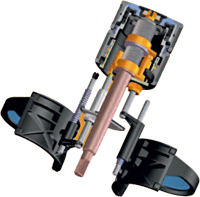 Leica Binocular Center Focus Mechanisms these are engineered to provide ease of use (central focus), quick and smooth performance, and a lifetime of reliable service. The focus mechanism is an "internal" arrangement where optics within the binocular body are moved to accomplish changes of focus. So the exterior does not change, the length of the binocular does not change with focus. This internal central focus mechanism makes it a quick and simple matter to change focus from very close objects out to infinity. And by means of this advanced mechanical arrangement the binocular is sealed well from moisture, dirt and other contaminants.
Leica Binocular Center Focus Mechanisms these are engineered to provide ease of use (central focus), quick and smooth performance, and a lifetime of reliable service. The focus mechanism is an "internal" arrangement where optics within the binocular body are moved to accomplish changes of focus. So the exterior does not change, the length of the binocular does not change with focus. This internal central focus mechanism makes it a quick and simple matter to change focus from very close objects out to infinity. And by means of this advanced mechanical arrangement the binocular is sealed well from moisture, dirt and other contaminants.
Left: Ultravid HD internal focusing mechanism. Rotating the focus collar drives a focusing lens element in each optical barrel (34,591 bytes).
Click on image to see enlarged view (65,030 bytes).
And focusing the Ultravid HD is even smoother than ever before. The mechanism remains free of play across the entire range. Optimized material pairings and gliding discs made from extremely tough, high-performance plastic are used. In cold conditions, the conventional greased focusing mechanisms sometimes only work with difficulty, and at higher temperatures they move too freely. Furthermore, these focusing mechanisms can feel "sticky", and at higher temperatures there is even the danger that grease can off gas or escape and run on the lens. With the optimized Leica focus, these risks have been eliminated. The new mechanics of the Ultravid HD models work practically without any lubricants. So even in extreme temperatures it is always fully functional and with a constantly optimal degree of smoothness.
Being mechanical systems, they may require only minor cleaning and/or lubrication service after years or decades of service - depending on the amount of use and the operating environment!
Background: How The Eye Works a binocular can be thought of as a light funnel gathering light through its objective (front) lens, with prisms to erect the image, and with an eyepiece funneling light into the eye.
The entrance pupil is the black spot in the center of the iris, this is the opening in the iris through which light passes. Between the cornea and the iris is the anterior chamber filled with vitreous fluid, a clear jelly-like solution. Light passes through the vitreous on it's way to the retina. The retina is lined with light-sensitive sensors (cones and rods) that accumulate the visual signal and then transmit the information through the optic nerve to the brain where the signals are processed. And so by dilating and exposing more sensors to the stimulis, then the Iris causes the eye to compensate with increased area what is lacked in intensity can provide reasonably good views of fainter areas at night.
Diopter Adjustment As people age it is likely their vision will change in focus near or distant or both for example, and one may develop astigmatism too. Changes of the eye tend to result in various degrees of myopia (nearsightedness) or hyperopia (farsightedness). In a single tube such as a telescope we simply focus to accommodate differences between observers. But with binoculars it is necessary not only to focus to accommodate differences between people, but to also have some mechanism to compensate for differences between the left and right eyes.
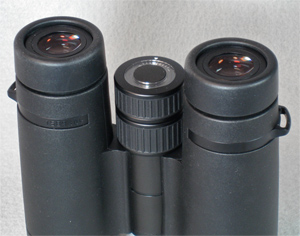 Leica binoculars incorporate mechanisms to compensate for differences between the left and right eyes, this adjustment is known as the "diopter adjustment". The exact mechanical arrangement varies but the principle of operation remains the same, that is to allow the observer to incorporate a consistent variable into the focusing. To adjust this in the mid to larger Leica binoculars one simply:
Leica binoculars incorporate mechanisms to compensate for differences between the left and right eyes, this adjustment is known as the "diopter adjustment". The exact mechanical arrangement varies but the principle of operation remains the same, that is to allow the observer to incorporate a consistent variable into the focusing. To adjust this in the mid to larger Leica binoculars one simply:
1. dial the focus knob to achieve approximate focus
Left: Ultravid HD internal focusing mechanism. Rotating the focus collar drives a focusing lens element in each optical barrel (34,591 bytes).
2. gently pull the focus knob up (away from the binocular bridge)
3. now turn the protruding dial clockwise or counterclockwise to achieve best focus for the right eye
4. without turning the extended dial, turn the inner dial (adjacent the binocular bridge) clockwise or counterclockwise to achieve best focus for the right eye
5. without turning either dial, gently push the extended knob back into place to reseal the focus mechanism.
Drag your Mouse Cursor back and forth over the image to see Focus Diopter Dial extend and retract. Note the red waterproofing seal O-ring.
It is also possible that over time, some of the detrimental aspects may change in a way that improves vision too.
As well as the high grade lightweight structural materials including a housing made of magnesium, a central hinge shaft of extremely sturdy titanium - which materials could possibly be more robust and lighter at the same time?
Brighter: This development is achieved by Leica's continued application of state of the art computer aided optical design, and by the use of special high grade optical raw glass materials. With the help of recently developed fluoride (FL) glass the Leica HD and APO APO-TELEVID spotting telescopes models offer supreme color fidelity and contrast. Optical FL lenses are to a large part made up of calcium fluoride, a mineral with a crystalline structure. Unlike conventional optical lenses, this creates a very low level of dispersion (light scattering) and corrects aberration (imaging errors) significantly better than previous glasses. So as a result the viewing experience is more natural and three-dimensional, more impressive than it has ever been before.
The optics incorporate the new HighLux System (HLS™), this is an optical coating that is unequalled in its quantity and uniformity of transmission of light in the visible spectrum. The HLS™ coatings consist of a precisely applied forty three (43) layer coating, with each layer applied as thin as only 40 nanometers. By means of a special mirror layer on the prism system the process yields a level reflection of 99.5 %; it was possible to raise the image brightness to this level over the prior generation models. This among those attributes that makes the impressively high resolution imaging performance, and striking enhanced contrast possible.
Leica AquaDuraTM ensures greater visibility in wind and rain
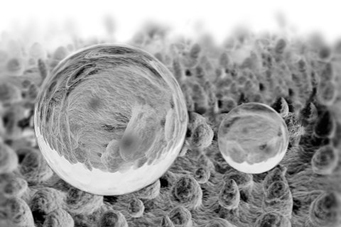 It is a cold morning and the lens fogs up - that is not much fun. Fingerprints, dust and rain are also annoying when viewing. The innovative Leica AquaDuraTM coating considerably reduces these disturbing factors. Imitating nature as with the lotus plant, this new water and dirt-resistant protective layer on the outer glass surfaces ensures that dirt and moisture are barely able to take hold on the specially adapted surface structure of the optic. This is the same coating applied by Leica for their latest APO-TELEVID spotting telescopes introduced in 2007 and coming available in 2009.
It is a cold morning and the lens fogs up - that is not much fun. Fingerprints, dust and rain are also annoying when viewing. The innovative Leica AquaDuraTM coating considerably reduces these disturbing factors. Imitating nature as with the lotus plant, this new water and dirt-resistant protective layer on the outer glass surfaces ensures that dirt and moisture are barely able to take hold on the specially adapted surface structure of the optic. This is the same coating applied by Leica for their latest APO-TELEVID spotting telescopes introduced in 2007 and coming available in 2009.
Right: Microscopic image of water droplet demonstrating the operating principle of AquaDura (32,870 bytes).
Click on image to see enlarged view (47,295 bytes).
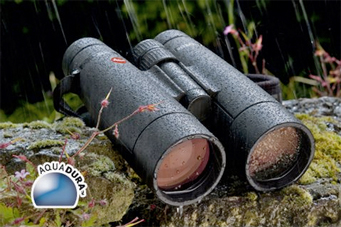 On the previous generations of anti-reflection coating the water tended to bead on the optical surface, this is particularly distracting on the eyepiece lenses being closer to focus. But with Leica AquaDuraTM the water droplets do not adhere, and the surface is also resistant to the formation of fog that would otherwise reduce contrast if not completely obscure the object of the observation.
On the previous generations of anti-reflection coating the water tended to bead on the optical surface, this is particularly distracting on the eyepiece lenses being closer to focus. But with Leica AquaDuraTM the water droplets do not adhere, and the surface is also resistant to the formation of fog that would otherwise reduce contrast if not completely obscure the object of the observation.
Left: Leica AquaDura applied on the right objective lens of a Leica binocular. Compare this with previous generation high transmission coatings applied on the left objective (82,183 bytes).
Click on image to see enlarged view (142,864 bytes).
reduced cleaning efforts required leaves you more time for viewing!
Stronger: As if the Leica durability was not already good enough, Leica takes this too to another level of endurance. The housing of the ULTRAVID HD is made of a diecast all metal magnesium chassis. This provides light weight and great strength compared to aluminum. And the ULTRAVID HD frame has nearly twice the thickness and strength of any competing magnesium or magnesium composite binocular made today.
The critical oversized Center Axis Shaft is made of extremely rigid and durable titanium. This is highly resistant to wear, contributes to structural integrity, and is a critical aspect of maintaining precise alignment of the binocular over a lifetime of service.
The critical parts of the focusing system of the ULTRAVID HD which begins with the titanium Center Axis Shaft, utilizes a precise helicoid gearing mechanism. This is smoother, more durable, and more costly choice than the spur gear drive and materials employed by many competitors.
The ULTRAVID are now highly shock resistant, are nitrogen purged to be fogproof, are waterproof to a depth of 5 meters (16.5 feet), and will function over an extremely broad range of temperatures of from -25 degrees C (-13 degrees F) up beyond where most humans can endure.
The ULTRAVID BL brings with it a refined hard-shell carrying case made of leather with zip up side strips. This case is designed so that the straps from the binocular come through open slots at either side of the top of the case; the strap of the binocular supports both.
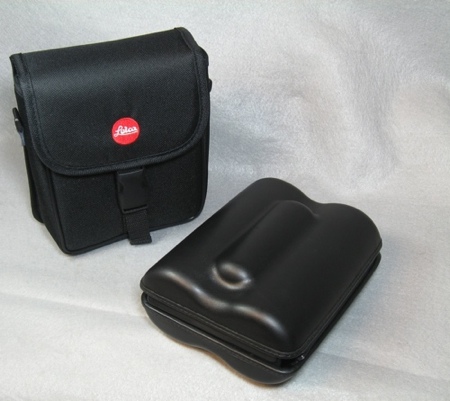

Above: at left is the black nylon pouch provided with Leica ULTRAVID BR Binoculars, at right the hard leather case provided with the ULTRAVID BL (67,029 and 70,573 bytes).
click on images to see enlarged views (358,480 and 318,497 bytes).
PERFORMANCE OVERVIEW
The 42mm aperture ULTRAVID HD series provide a great balance of resolving power, and portability. And ready for most daylight, early morning and dusk light conditions. These models achieve an image brightness that was impossible before now in a 40 to 42mm roof prism binocular. And their images will appear brighter even when compared against other less sophisticated models even with larger aperture objective (front) lenses.
Right: Leica ULTRAVID 42mm Series Binocular (in appearance identical to HD)
click on image to see enlarged view (181,339 bytes)
The remarkably slim and compact housings assure these binoculars can easily be put into a large coat pocket, into a brief case or travel bag, making these a very handy binocular to travel with - having a binocular available is just as important as its optical properties.
To make it even easier to carry and deploy Company Seven offers an optional "holster" custom fitted to hold this binocular. This is made of heavy duty leather, finished in black. It is similar in quality and construction to conventional heavy duty leather pistol holsters. This accessory can be attached onto a belt and it incorporates a leather strap to keep the binocular in place. The holster protects the objective (front) lenses of the binocular, and we include a smaller leather strap to attach the furnished binocular rain guard onto the binocular to protect the eyepieces. The holster provides excellent protection, and ready access to the binocular while hiking or climbing. Furthermore, one no longer needs to carry the binocular with the strap, it now becomes a quick and simple matter to "draw" the binocular and share it with others without the nuisance of having to clear a dangling strap over your jacket hood, hat or sunglass straps.
ULTRAVID HD AND BL BINOCULAR SPECIFICATIONS
| Binocular | Magni- fication |
Front lens diameter |
Exit pupil |
Twilight factor |
Field of view | Near focusing distance |
Dimensions | Weight | Eye Relief | ||||||||||||
| LEICA ULTRAVID 7 X 42 HD | 7 x | 42 mm | 6 mm | 17.1 | 140 m/1000 m | 3,3 m / 11 ft m approx. | 121 x 142 x 67 mm | 765 g | 17mm | ||||||||||||
| LEICA ULTRAVID 8 x 42 HD / 8 x 42 BL | 8 x | 42 mm | 5.25 mm | 18.3 | 130 m/1000 m | 3.1 m approx. | HD: 121 x 142 x 67 mm BL: 121 x 142 x 63 mm mm |
HD: 790 g BL: 710 g |
15.9mm | ||||||||||||
| LEICA ULTRAVID 10 x 42 HD / 10 x 42 BL | 10 x | 42 mm | 4.2 mm | 20.5 | 110 m/1000 m | 2.95 m approx. | HD: 121 x 147 x 67 mm BL: 121 x 146 x 63 mm mm |
HD: 765 g BL: 695 g |
15.8mm |

